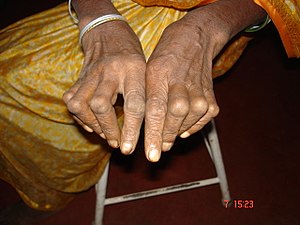Boutonniere deformity
| Boutonniere deformity | |
|---|---|
 | |
| Boutonniere deformity in a person with rheumatoid arthritis | |
Boutonniere deformity is a deformed position of the fingers or toes, in which the joint nearest the knuckle (the proximal interphalangeal joint, or PIP) is permanently bent toward the palm while the farthest joint (the distal interphalangeal joint, or DIP) is bent back away (PIP flexion with DIP hyperextension). Causes include injury,[1] inflammatory conditions like rheumatoid arthritis, and genetic conditions like Ehlers-Danlos syndrome.[2]
Signs and symptoms
Complications
The complications of Boutonniere deformity are as follows:[3]
- Chronic joint stiffness
- Post-traumatic arthritis
- Decreased range of motion
Pathophysiology
This flexion deformity of the proximal interphalangeal joint is due to interruption of the central slip of the extensor tendon such that the lateral slips separate and the head of the proximal phalanx pops through the gap like a finger through a button hole (thus the name, from French boutonnière "button hole"). The distal joint is subsequently drawn into hyperextension because the two peripheral slips of the extensor tendon are stretched by the head of the proximal phalanx (note that the two peripheral slips are inserted into the distal phalanx, while the proximal slip is inserted into the middle phalanx). This deformity makes it difficult or impossible to extend the proximal interphalangeal joint.
Diagnosis

In the evaluation radiographs are used to determine if fractures exist and severity of any hyperextension[3]
Stages
- Mild extension lag, passively correctable
- Moderate extension lag, passively correctable
- Mild flexion contracture
- Advanced flexion contracture
Higher numbers indicate a more severe problem and greater likelihood of a poor outcome.
Treatment
Usually treated with a splint placing the proximal interphalangeal joint in extension for 4–6 weeks. Occasionally surgery is needed when splinting is unsuccessful.
See also
References
- ↑ "Boutonniére Deformity". Your Orthopaedic Connection. American Academy of Orthopaedic Surgeons. Archived from the original on 15 April 2018. Retrieved 15 April 2018.
- ↑ "Boutonniere Deformity". Archived from the original on 2023-02-26. Retrieved 2022-06-28.
- ↑ 3.0 3.1 Binstead, Justin T.; Tafti, Dawood; Hatcher, Jason D. (2023). "Boutonniere Deformity". StatPearls. StatPearls Publishing. Archived from the original on 2023-08-20. Retrieved 2023-08-17.
Further reading
- Coons, Matthew S.; Green, Steven M. (August 1995). "Boutonniere deformity". Hand Clinics. 11 (3): 387–402. doi:10.1016/S0749-0712(21)00060-3. PMID 7559817.
- Souter, William A. (October 1974). "The Problem of Boutonniere Deformity". Clinical Orthopaedics and Related Research. 104 (104): 116–133. doi:10.1097/00003086-197410000-00012. PMID 4607222.
- Nalebuff, Edward A.; Millender, Lewis H. (July 1975). "Surgical Treatment of the Boutonniere Deformity in Rheumatoid Arthritis". Orthopedic Clinics of North America. 6 (3): 753–763. doi:10.1016/S0030-5898(20)30987-1. PMID 1099508.
- Littler, J. William; Eaton, Richard G. (October 1967). "Redistribution of Forces in the Correction of the Boutonnière Deformity". JBJS. 49 (7): 1267–1274. doi:10.2106/00004623-196749070-00002. PMID 5622971.
- To, Philip; Watson, Jeffry T. (January 2011). "Boutonniere Deformity". The Journal of Hand Surgery. 36 (1): 139–142. doi:10.1016/j.jhsa.2010.10.032. PMID 21193133.
- Massengill, James B. (November 1992). "The boutonniere deformity". Hand Clinics. 8 (4): 787–801. doi:10.1016/S0749-0712(21)00744-7. PMID 1460075.
- Aiache, Adrien; Barsky, Arthur J.; Weiner, Daniel L. (August 1970). "Prevention of the boutonniere deformity". Plastic and Reconstructive Surgery. 46 (2): 164–167. doi:10.1097/00006534-197008000-00010. PMID 5423482. S2CID 39268503.
- Curtis, Raymond M.; Reid, Robert L.; Provost, John M. (March 1983). "A staged technique for the repair of the traumatic boutonniere deformity". The Journal of Hand Surgery. 8 (2): 167–171. doi:10.1016/s0363-5023(83)80009-4. PMID 6833725.
- Urbaniak, James R.; Hayes, Michael G. (July 1981). "Chronic boutonniere deformity—An anatomic reconstruction". The Journal of Hand Surgery. 6 (4): 379–383. doi:10.1016/s0363-5023(81)80048-2. PMID 7252114.
- Dolphin, James A. (January 1965). "Extensor Tenotomy for Chronic Boutonnière Deformity of the Finger: REPORT OF TWO CASES". JBJS. 47 (1): 161–164. doi:10.2106/00004623-196547010-00011. PMID 14256963.
External links
| Classification | |
|---|---|
| External resources |